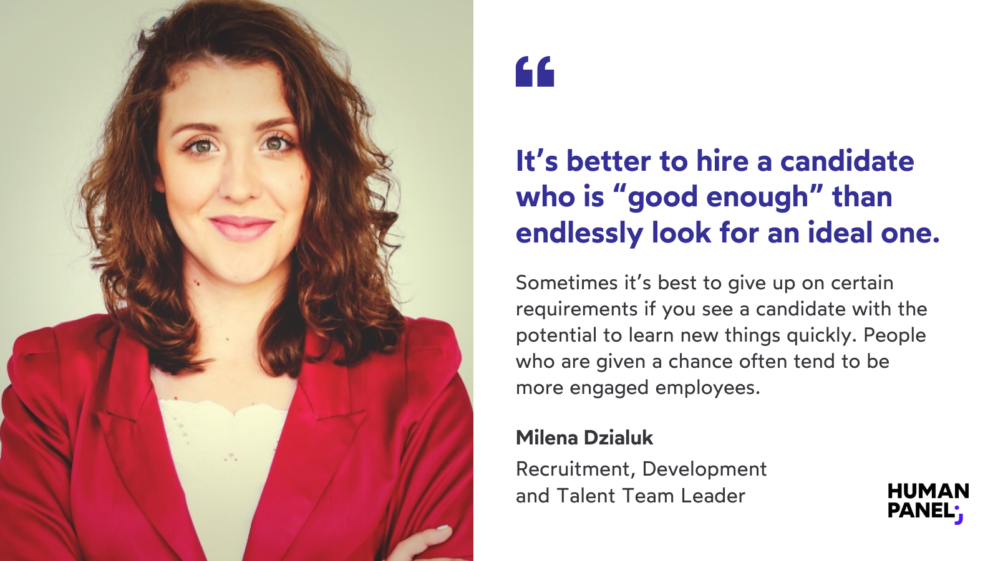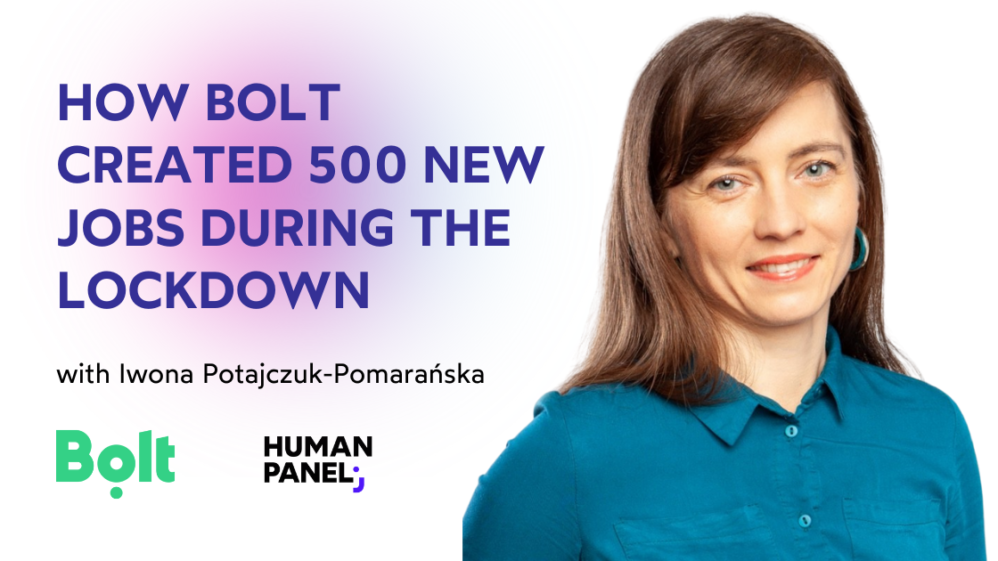Connectis_: What’s the secret to successful IT talent acquisition?

With IT specialists receiving dozens of offers every day, successful IT talent acquisition remains one of the biggest challenges for HR professionals. What is the secret ingredient of an effective IT recruitment strategy? Milena Dzialuk of Connectis_ shared her insights with us.
The demand for IT professionals is growing, and so is the demand for IT recruiters. What does the IT talent acquisition and recruitment process look like? What are the key skills of an IT recruiter? And what HR metrics are critical to an effective process?
Human Panel spoke with Milena Dzialuk, Recruitment, Development & Talent Team Leader at Connectis_, one of the leading companies outsourcing services for IT specialists, project teams and IT projects.
Connectis_ enables companies around the world to hire top specialists IT for a specific project and deliver it accurately and on time. The company is growing rapidly and currently employs a team of over 200 people. The talent acquisition team consists of 10 researchers, 9 recruiters and 2 team leaders.
Human Panel: How would you describe your recruitment strategy?
Milena Dzialuk, Recruitment, Development & Talent Team Leader at Connectis_: Our strategy is extremely flexible and depends on the market, which is very dynamic and grows rapidly.
The pandemic has accelerated certain processes. The market has become global, which has both its advantages and drawbacks. For example, we can acquire candidates from all over the world but at the same time, they can look for jobs globally. In such a highly competitive market, IT talent acquisition stands out as a major challenge.
This is why we constantly adjust our recruitment strategy, depending on the current circumstances and a specific project we work on. We use multiple tools and tactics – from social media, to recruitment marketing and employer branding initiatives. All depends on who we are looking for, and what’s the demand and supply on the market.
The competition for IT specialists is extremely tight and we can speak about the employee market in this industry. Given these circumstances, what makes tech talent acquisition effective today?
From my perspective, the key is open and honest communication. The best IT specialists receive dozens of offers daily, and they need to know what to expect straight away. There is no room for beating around the bush – it’s best to come to the point and present the relevant information immediately.
Another crucial factor is asking the potential candidates what they are searching for and in what project they would like to participate.
I would also say that it’s almost impossible to find “a perfect match”. Therefore, it’s better to hire a candidate who is “good enough” than endlessly look for an ideal one.
Sometimes it’s best to give up on certain requirements if you see a candidate with the potential to learn new things quickly.
Milena Dzialuk
So is it better to hire juniors and train them than look for senior employees?
There is no simple answer to this question. First, it all depends on who we call “a junior”. Is it a person with no experience at all looking for an entry level position? Or someone who has under 2 years of experience? There are people who have 2-3 years of commercial experience but have been programming for years out of passion. Also, some people decide to re-skill at some point in their career. They become IT professionals but they already have experience in project management, team leading or other fields, which can be a valuable asset!
Given that, I would say we need to stay alert to any promising candidate, even if they lack some of our requirements. Some companies fear that the juniors they hire and train will quickly move to another employer. This is a faulty belief. People leave when they lack challenges and development – and they usually signal that before they make the decision to leave.

Of course, there’s always the risk of employee turnover but it’s a natural process. We no longer stay with one company for 20 years. We look to new challenges and paths of development – and it’s as sane as it’s inevitable.
One more thing I’d like to point out in the context of hiring juniors is that we should always ask ourselves: do we have the resources to take someone’s time and devote it to a new person’s training? Can we afford to give our junior a buddy? If the answer is “yes”, I see no reason why we wouldn’t give a chance to a junior, notably because people who are given a chance often tend to be more engaged employees.
You mentioned that honest and open communication is vital in today’s tech talent acquisition. Does it include being transparent about the salary? Are salary bands a must today?
They’ve become a standard but – what’s worth mentioning – sometimes we can’t disclose them at an early stage of the recruitment process. Despite that, salary is what many candidates ask for first. They want to know what they stand upon before they continue.
However, what also counts is the tech stack, tools, and projects. IT specialists want to grow and develop their skills, work with the newest technologies and learn new capabilities.
Is speed a critical factor in the recruitment process?
Yes and no. If an IT specialist has several great offers on the table, time is crucial. A company that stretches the recruiting process in time can easily lose a candidate. Speed counts, especially because the tech industry is very agile itself.
But I am not an advocate of a super-speedy process that is like: Monday – first call, Tuesday – interview, Wednesday – offer. Most people like to get a more in-depth idea of the company that offers them a job. Who will I be working with? What’s the atmosphere like? What exactly will I be responsible for? These are important questions, too.
We have to think about time in recruitment but we also need to build relationships with candidates and provide them with as much information as possible. It’s crucial to communicate, establish trust and be transparent about the expectations.
Milena Dzialuk
What else – apart from time – counts in the candidate experience?
I think that you need to design the entire candidate’s path well and deliver the right message at the right time – both for the candidate and the client. Today the candidate experience begins long before the first contact with the candidate and lasts throughout the onboarding phase and the new hire’s first months in the organization.
What helps in designing this path?
On one hand it’s personalization, addressing the candidates’ needs individually, or giving personalized feedback. On the other it’s automation which makes the process faster.
At Connectis_ each client can have a different recruitment process – so we try to adjust and recognize the needs adequately.
Obviously, we also collect various data points throughout the process and analyze them. We monitor such metrics as time to hire or time to fill but we also focus on qualitative feedback.
Let’s talk about recruiting recruiters and talent sourcers in IT. How to become one? What skills and capabilities are crucial?
I observe a huge surge in job offers for IT recruiters – and soon we’ll need even more of them. One thing worth remembering is that it’s a very agile and dynamic environment. You don’t just sit and wait for the candidates – you must outreach specific people, source and search for appropriate applicants. Therefore, you must be very active, and not afraid of negotiating, discussing the job with a candidate and having an opinion.
Also, a modern tech recruiter must learn constantly and be up to date with technological updates. Technological knowledge is also a must – at a level that allows to evaluate the candidate’s skills.
Education, communication, openness, flexibility and pro-sales attitude – these are the crucial factors needed in the IT recruitment world.
Milena Dzialuk
Do you observe an ongoing specialization of the recruiter’s role?
Absolutely. Even at Connetis_, we no longer look for “general recruiters” but people who are more specialized in the IT field. As the tech industry grows, HR roles in tech companies grow and develop along with them. There are lots of opportunities – so if you feel it’s your path, feel welcomed.
For a successful IT talent acquisition, you need more than just an ATS. The recruitment is only the beginning of the employee’s life cycle in the organization. Try people analytics to get a better overview of the data landscape and see the measurable business outcomes that come from HR initiatives. Sign up for a free demo of Human Panel and see the difference.




